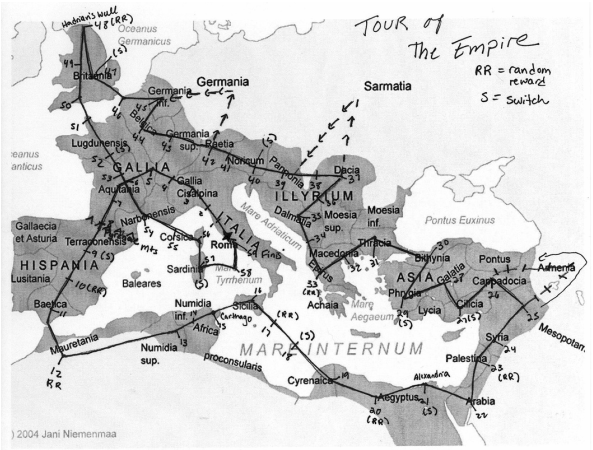 One of the most common ways to use whiteboards is to drill concepts: or check comprehension. You can either have students form verbs or nouns on the boards or have them answer concrete questions about a text. For example, you can ask students to write the form of the noun mater that would follow cum. on the boards. Or, write the translation of this verb: putabam. While not very imaginative, drill and repeat is a useful teaching technique for practicing some aspects of any language. However, students get bored with this activity and frankly, so do I. In order to engage students when I really needed to spend some time drilling a certain concept or group of concepts, I invented this game, which I call "Tour of the Empire." It has been entertaining and instructive with all levels of Latin, both middle and high school. The board is below. A full size copy can be found here in the Google drive folder linked here: under the Card and Board Games tab. This game cam be played individually or in partners. Either way, each student or partner needs a copy of the game board, a whiteboard and marker and a six sided die. You can have groups share the die if you don't have enough. How to Play:
Students mark on the game board at the starting position which is numbered as "1" and is in Roma. You then ask students a grammatical or comprehensin question - anything that has a definitive answer. They write the answer on the whiteboards. You then tell the group to hold up their whiteboards, tell them the correct answer. Students who got the answer correct, roll the die and move the number of spaces on the game board. They then make a new mark where they are. Students who did not get the answer correct, stay where they are. On the board, there are two different abbreviations by some of the numbers. Some spaces have an "S" marked and other say "RR." "S" stands for switch. A student landing on a space with an "S" must switch their board with another player or pair of players. My rule is that this must be done quickly, without making a survey of the room to see who is furthest ahead. The player who got the "S" takes the board of the player and gives that player, their board. If it turns out that they accidentally switched boards with a player who was actually further behind, too bad. RR stands for random reward. A student landing on that space simply raises their hand tells me that the have a random reward. What reward you decide to give out is up to you. I usually tell students to move ahead between 2-5 spaces. Sometimes, if they've been to chatty, I simply say, "No Random Reward for you." I warn them about this before the game begins and it tends to cut down on the talking. Play is over when one student makes it all around the empire or you run out time. In that case, survey the class and declare the student who is the furthest ahead to be the winner. Variations: This game can take 40 minutes to play and often no one makes it to the end. If you want to play a speedier version of this, have everyone roll and move regardless of whether or not they got the answer right. Have students who got the answer right, roll twice. This version will take only about 20 minutes before someone completes the tour. There is no reason to use this particular board. I created it because I wanted students to spend some more time looking at the geography of the empire. I never seem to be able to devote enough time to that topic. Other teachers with whom I have shared this game with, have made street maps of Pompeii. I think the underworld would make a great board as well. Throw in an S and a RR about every 12 spaces and it should work fine.
0 Comments
Leave a Reply. |
- Salvete Omnes!
- About Me
-
The Stuff is Here
- Beginning Activities
- Card and Board Games
- Kinetic Activities: Get 'em out of their seats
- Mad-libs for All Levels
- Miscellaneous Low or No prep Activities
- Movie Talks!
- Stories Not in Your Textbook
- Stuff for Advanced Students
- Teaching Case
- This I Believe
- White board Activities: Winning.
- Writing in Latin with Students
- Mythology RPG
- Songs
- Quid Novi?
- Links!
- TRES FABULAE HORRIFICAE
- LEO MOLOSSUS
- OVIDIUS MUS
 RSS Feed
RSS Feed
